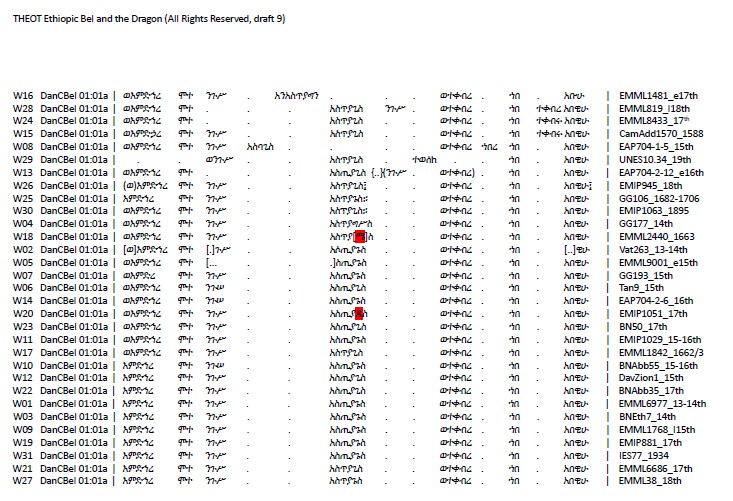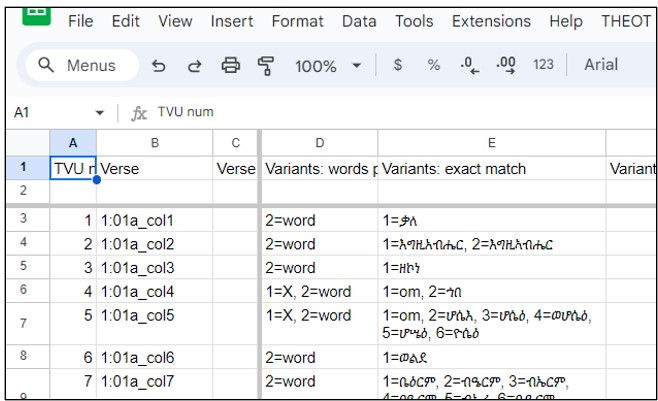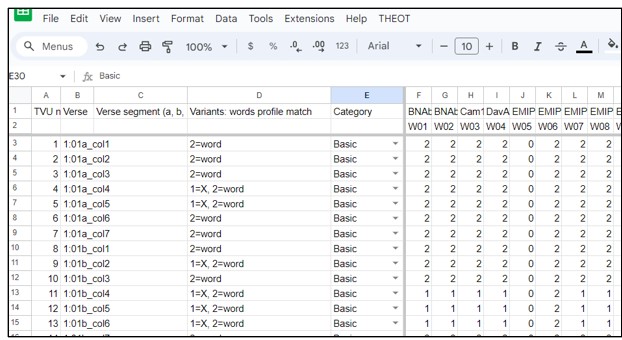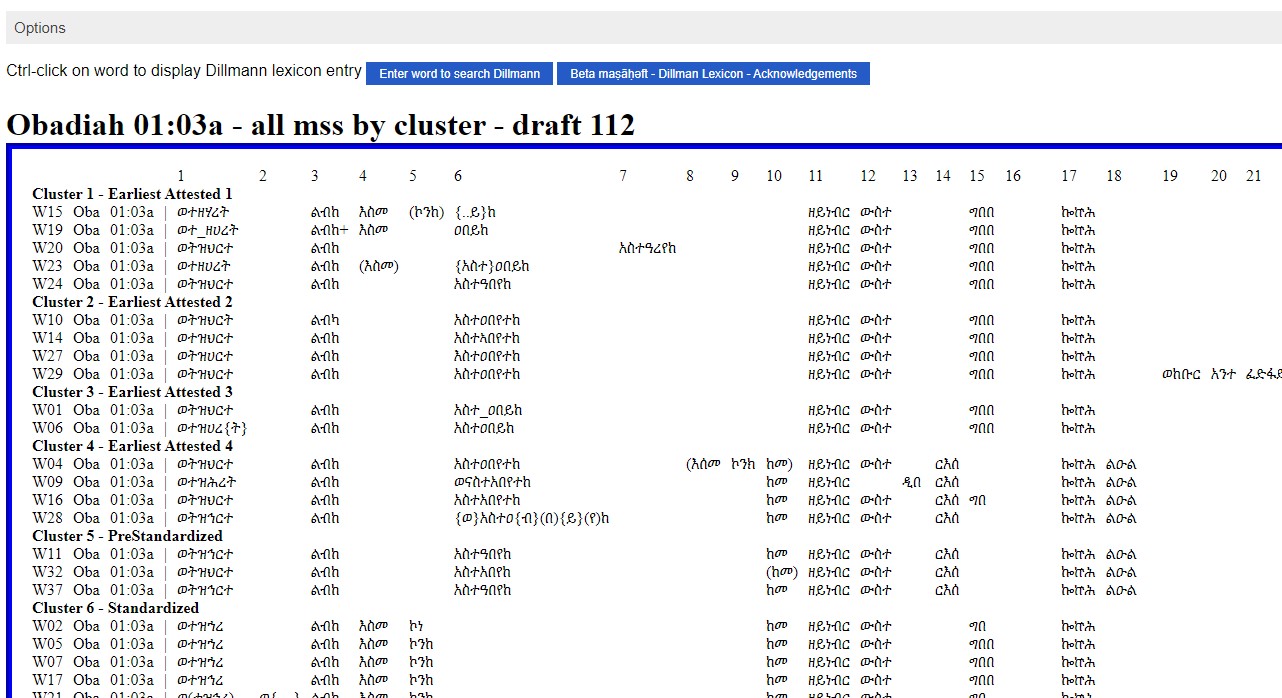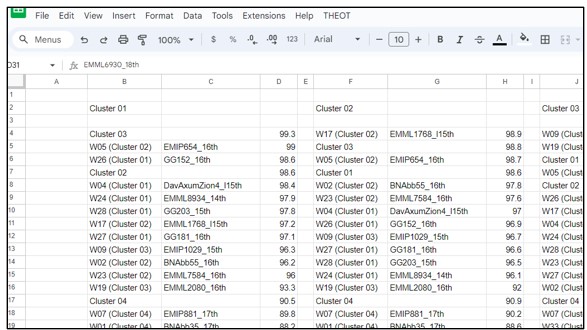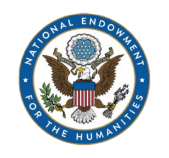Materials for the
Study of Ethiopic
Bel and the Dragon
We...
Turn text into numbers.
Identify patterns in the numbers.
Turn numbers into stories.
Ethiopic Bel and the Dragon
Stuffs1-goes-here
Aligned
Texts
Texts
The PDF is a copy of the document file in which we aligned all the words of all the manuscripts in this study. Click the image on the left to download the pdf file. Click the image on the right to see a video explaining how this data was produced or processed.
Variants
The spreadsheet shows the data produced by the THEOT script labeled “create database of variants”. Click the image on the left to open a copy of the spreadsheet. Click the image on the right to see a video explaining how this data was produced or processed.
Words
Profile
Match
Profile
Match
The spreadsheet shows the data produced by the THEOT script labeled “process database of variants”. Click the image on the left to open a copy of the spreadsheet. Click the image on the right to see a video explaining how this data was produced or processed.
Dendrogram
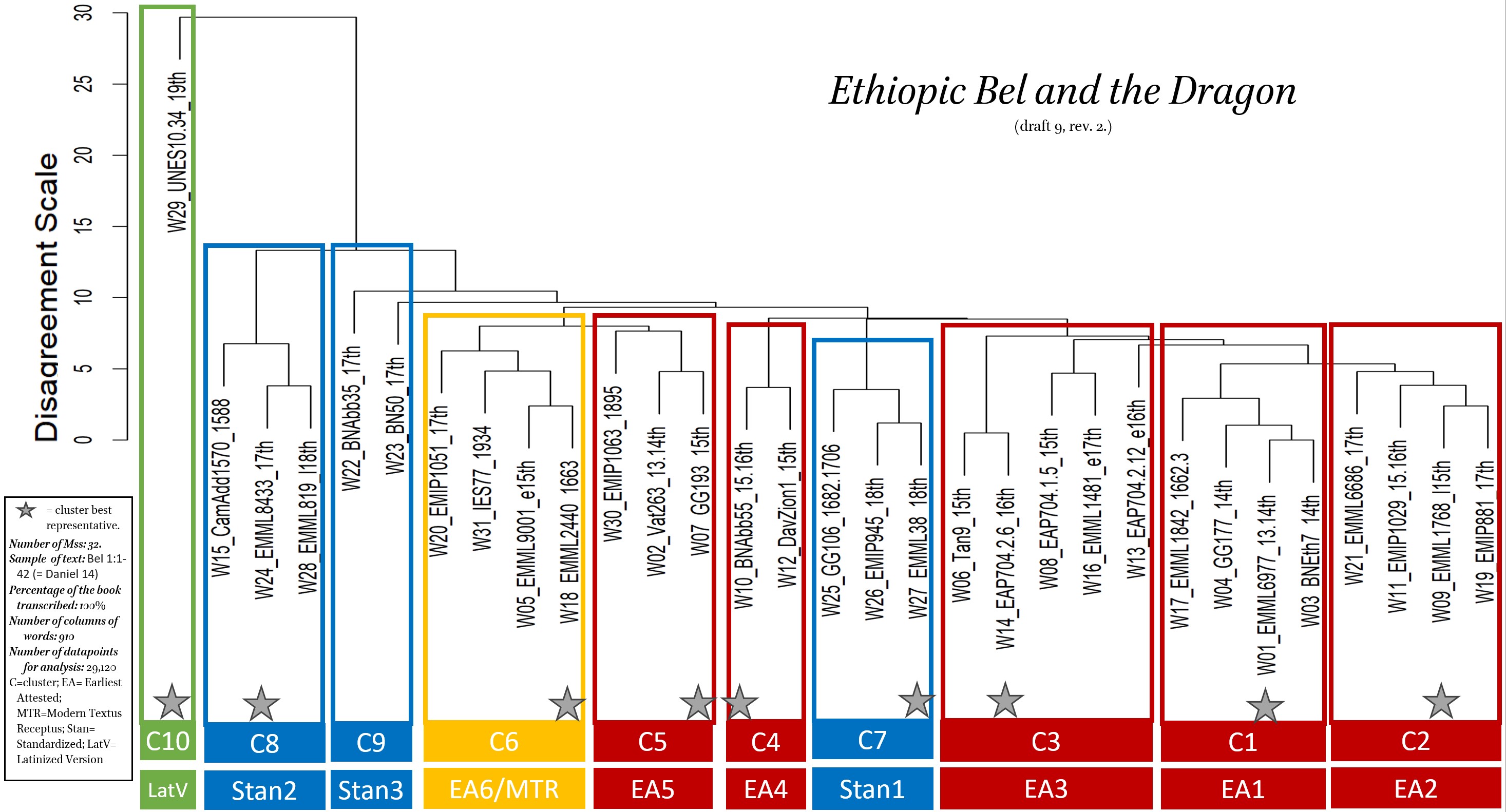
The jpeg shows the Dendrogram produced by feeding the R file and a CSV (comma separated values) file into the R program to generate a dendrogram. The colored boxes and stars represent our interpretation of the dendrogram, and become our working hypothesis for investigation of the book. Click the image on the left the dendrogram. Click the image on the right to see a video on THEOT Dendrograms and How to Use them.
THEOT
Text
Viewer
Text
Viewer
These links explore the THEOT Text Viewer and How to Use It. Click the image on the left to open the website directly. Click the image on the right to see a video introducing the Text Viewer and How to Use it.
Best
Representative
Manuscripts
Representative
Manuscripts
The spreadsheet shows a series of tabs that represent the various stages of processing the data with a view of identifying the best representative manuscript for each cluster. Click the image on the left to open a copy of the spreadsheet. Click the image on the right to see a video explaining how this data was produced or processed.
Bel and the Dragon: Sample, Best Representatives, Minor Recensions, Other Studies
- Sample of the Text: Bel 1:1-42 (= Daniel 14).
- Sample Size: 100% of the book.
- Sample of Manuscripts: 31. BN Abb 016 (19th), BN Abb 035 (17th), BN Abb 055 (15-16th), BN Abb 137 (19th), BN Eth 07 (14th), BN Eth 50 (17th), Cam Add. 1570 (1588), Dav Axum Zion 1 (15th), EAP 704-1-05 (15th), EAP 704-2-06 (16th), EAP 704-2-12 (e16th), EMIP 881 (17th), EMIP 945 (18th), EMIP 1029 (15-16th), EMIP 1051 (17th), EMIP 1063 (1895), EMIP 1070 (1914), EMML 38 (18th), EMML 0819 (l18th), EMML 1481 (e17th), EMML 1768 (l15th), EMML 1842 (1662/3), EMML 2440 (1663), EMML 6686 (17th), EMML 6977 (13-14th), EMML 8433 (17th), EMML 9001 (e15th), GG 106 (1682-1706), GG 177 (14th), GG 193 (15th), IES 77 (1934), Tanasee 9 (15th), UNES 02.10 (1913), UNES 02.11 (1927), UNES 10.34 (1931), Vat 263 (13-14th).
- Number of Data Points Generated: 28,210.
- Earliest Attested 1 Best Representative – EMML 6977 (13-14th).
- Earliest Attested 2 Best Representative – EMML 1768 (l15th).
- Standardized 1 Best Representative – EMML 38 (18th).
- Standardized 2 Best Representative – EMML 8433 (17th).
- Modern Textus Receptus Best Representatives – EMML 2440 (1663) and IES 77 (1934) represent the cluster well.
- Minor Recensions: UNESCO 10.34 (1931) represents a minor recension, translated from the Latin Vulgate, with a 30% degree of difference from the rest of the tradition. EMIP 949 (e20th) and EMML 7942 (20th sample) are manuscripts which carry this same minor recension, but in this case, the book is not present in the mss.
- Other findings related to Ethiopic Daniel: We have evidence of three distinct recensions of Ethiopic Daniel. The primary recension is carried in virtually all of the extant manuscripts of the Ethiopic tradition. The best representative of the earliest attested text can be found in BN Eth 7 (14th century). Vienna Eth 16 (a manuscript with text and commentary (tergwame) contains a second recension of the book of Daniel. See Löfgren, O. (ed.), Die äthiopische Übersetzung des Propheten Daniel (Paris: Paul Geuthner, 1927); and Sima, A., “kona yeqattel in einer Wiener Handschrift des äthiopisches Danielbuches,” Oriens Christianus 87(2003):123–29. who studied it and concluded that it was a new translation from Arabic. We discovered that EMIP 1074 contains a matching text to the one in Vienna Eth 16, giving us now two witnesses to this early recension (in terms of the extant manuscript tradition). Unfortunately, neither Vienna Eth 16 nor EMIP 1074 were included in our study of Ethiopic Daniel. However, Niccum wrote about it in “3.5 Daniel, Additions to, Ethiopic,” pages 158–160 in The Textual History of the Bible, vol. 2B, A. Lange and E. Tov, eds. (Leiden: Brill, 2018). We have identified in UNESCO 10.34 a third recension of Ethiopic Daniel. It appears to be another example of the translation of the Latin Vulgate into Ethiopic, as it clearly is in the minor prophets.
